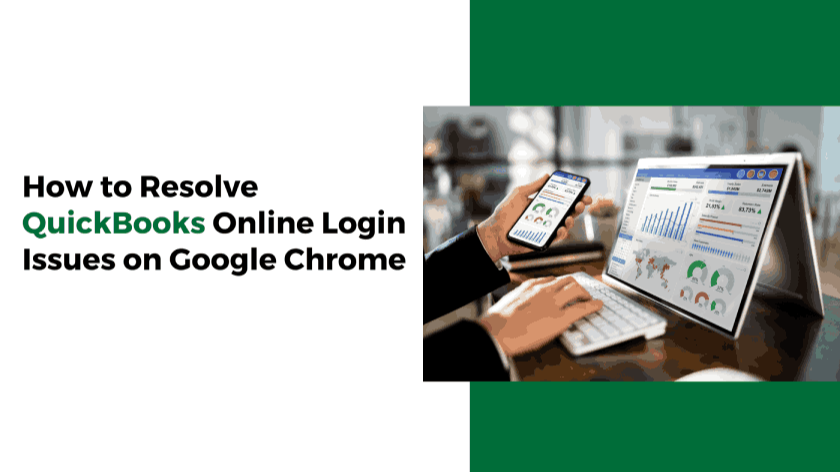Excerpt:
Experiencing trouble logging into QuickBooks Online on Google Chrome? This guide provides practical solutions to fix the issue. Common reasons for login problems include outdated browser cache, security conflicts, incorrect sign-out procedures, and interference from antivirus programs or password managers. Recommended troubleshooting methods include clearing browsing data, using incognito mode, marking Intuit as a trusted site, or setting up a new Chrome user profile. These steps will help you regain smooth access to your QuickBooks Online account.
QuickBooks Online (QBO) is a powerful tool for managing invoices, expenses, and company records. However, some users encounter login difficulties when trying to access their accounts via Google Chrome. This article will explore the root causes of these login errors and suggest effective fixes.
Understanding QuickBooks Online Login Errors on Chrome
Chrome login issues with QuickBooks Online often arise due to security concerns. Users may be prompted to upgrade to a more secure Intuit account. If you see an error message saying, "Account services unavailable, please try again later," this indicates a login problem.
Here are some common issues users may face when trying to log into QuickBooks Online via Chrome:
-
A loading message appears, but the page fails to load.
-
An error message states that the service is temporarily unavailable.
-
Chrome continuously redirects you between the login page and company selection screen, creating a frustrating loop.
Google Chrome is a widely used browser that pairs well with QuickBooks Online. However, various factors can cause login issues. In this article, we’ll explore the reasons behind these errors and how to fix them.

Some error messages that may appear during login problems include:
-
"Account services unavailable; please try again later."
-
A blank screen with a loading icon that never progresses.
-
A login loop where Chrome repeatedly redirects between the sign-in screen and the company selection page.
-
Messages such as "The services are not available," "Webpage cannot be found," "Error 404: File Not Found," or "QBO is currently unavailable, please try again later."
To troubleshoot QuickBooks Online login issues on Chrome, try running the browser in Incognito mode, adding Intuit as a trusted site, or applying other fixes outlined below.
What Causes QuickBooks Online Login Issues on Chrome?
Several factors can contribute to QuickBooks Online login failures on Chrome, including:
-
Firewall or Antivirus Interference: Security software like Windows Firewall or antivirus programs may block QuickBooks from connecting to the internet, preventing successful logins.
-
Failure to Properly Sign Out: If you didn’t log out correctly from your last session, Intuit’s security features might restrict access when you try to sign in again.
-
Saved Login Credentials in Password Manager: If Chrome’s password manager has stored outdated login details, it may interfere with authentication, causing login errors.
-
Browser Cache and History Buildup: An overloaded cache and excessive browser history can slow down Chrome’s performance, making it difficult to log into QuickBooks Online.
A Step-by-Step Guide to Resolving QuickBooks Online Login Errors in Google Chrome
Common Reasons for Login Issues & How to Fix Them
|
Error Causes
|
Solutions
|
|
Stored Cache and Cookies
|
Excessive cache and cookies in Chrome can disrupt the login process. If these files become outdated or corrupted, they may prevent the login page from loading correctly.
|
|
Extensions and Add-ons
|
Some Chrome extensions or add-ons may interfere with QuickBooks Online, leading to access issues.
|
|
JavaScript or Browser Configuration
|
If JavaScript is disabled or incorrectly set up, the login page may not function properly in Chrome.
|
|
Internet Connectivity Problems
|
A weak or unstable network connection can cause timeouts while trying to log in to QuickBooks Online.
|
|
Firewall or Security Restrictions
|
Overly aggressive firewall or security software settings may block QuickBooks Online from connecting to its servers.
|
|
Outdated Chrome Version
|
Running an older version of Chrome may result in compatibility issues, as it may not support the latest security updates required by QuickBooks Online.
|
|
Incorrect Login Information
|
Entering the wrong username or password, or encountering account-related problems, may prevent access to QuickBooks Online.
|
|
Two-Step Authentication Issues
|
If multi-factor authentication is enabled, difficulties in receiving verification codes may block access.
|
To prevent these issues and ensure smooth access to QuickBooks Online, follow the solutions below.
Quick Fixes for Common QuickBooks Login Errors
Issue: Firewall or Security Software Blocking QuickBooks
-
Cause: Certain antivirus programs or firewall settings may prevent QuickBooks from accessing the internet, limiting access to company files and invoicing features.
-
Solution: Open Chrome in Incognito Mode and add Intuit as a trusted site. This helps prevent security applications from blocking QuickBooks Online.
Issue: Previous Session Was Not Logged Out Correctly
-
Cause: If you didn’t log out properly in your last session, security measures by Intuit may prevent you from signing in again.
-
Solution: Restarting Chrome can help resolve common issues like slow performance, frozen pages, or unexpected crashes, ultimately fixing login-related errors.
Issue: Saved Login Credentials Preventing New Sign-In
-
Cause: Chrome’s password manager may store outdated login credentials, stopping you from entering your details correctly.
-
Solution: Create a new Chrome user profile to avoid conflicts and ensure a hassle-free login to QuickBooks Online.
Issue: Slow Browser Performance Due to Cache and History
-
Cause: Excessive stored cache and browsing history can slow down Chrome and lead to errors when trying to open QuickBooks Online.
-
Solution: Clear your cache and browser history to remove outdated files and fix loading or formatting issues, ensuring smooth access to QuickBooks Online.
Important Considerations Before Resolving QuickBooks Online Login Errors on Chrome
Experiencing login issues with QuickBooks Online on Google Chrome can be frustrating, but before applying any fixes, it’s essential to consider a few key factors to ensure a smooth troubleshooting process:
-
Check Browser Compatibility: Ensure that your version of Google Chrome is up-to-date and fully compatible with QuickBooks Online. Outdated browsers can lead to unexpected login problems.
-
Verify Browser Settings: Confirm that QuickBooks Online is correctly configured to work with Chrome, and that there are no conflicting extensions or settings causing issues.
-
Enable JavaScript and Cookies: JavaScript and cookies must be enabled in your Chrome settings. If these features are turned off, it could prevent QuickBooks Online from functioning properly.
-
Review Security Software Settings: Sometimes, antivirus programs or firewalls can block QuickBooks Online’s access to the internet, leading to login failures.
Keeping these considerations in mind will help you troubleshoot and resolve the problem efficiently.
Effective Solutions to Fix QuickBooks Online Login Errors in Chrome
Below is a list of proven solutions that can help you resolve login issues with QuickBooks Online when using Chrome:
|
S.No
|
Solutions
|
|
1
|
Try using a different web browser
|
|
2
|
Open Google Chrome in Incognito Mode
|
|
3
|
Clear browser cache, cookies, and history
|
|
4
|
Create a new user profile in Chrome
|
|
5
|
Adjust Internet Security and Privacy Settings
|
|
6
|
Check and update SSL settings in your browser
|
|
7
|
Modify privacy settings to allow QuickBooks Online
|
|
8
|
Reconfigure firewall and antivirus settings to prevent blocking
|
For the best and most secure experience with QuickBooks Online, always use a supported and regularly updated web browser.
Step-by-Step Solutions to Resolve QuickBooks Online Login Issues
Scenario 1: Security Software or Firewall Blocking QuickBooks Online Access
One of the common reasons users experience login errors with QuickBooks Online is due to interference from security applications, such as firewalls or antivirus software. These security measures may prevent QuickBooks from accessing the internet, causing frequent login disruptions.
Solution:
-
Open Google Chrome in Incognito Mode and try logging in to QuickBooks Online.
-
Add Intuit (QuickBooks Online’s parent company) as a trusted website in your security software settings to prevent login interruptions.
Step 1: Try opening the website in another web browser

If Chrome is causing login issues, but other browsers (such as Mozilla Firefox or Microsoft Edge) work fine, the problem may be Chrome-specific.
-
Alternative Solution: If you need to access QuickBooks Online urgently and Chrome isn’t working, use Internet Explorer to log in and export your data to QuickBooks Desktop.
-
Switching browsers can provide a temporary workaround while troubleshooting Chrome-specific issues.
Step 2: Open Chrome in Incognito Mode
Incognito Mode prevents Chrome from saving cookies, cache, or browsing history, which may sometimes be the cause of login failures.
How to Enable Incognito Mode in Chrome:
-
Open Google Chrome on your computer.
-
Tap on the menu (three vertical dots) in the top-right corner.
-
Select New Incognito Window from the dropdown menu.
-
Alternatively, press Ctrl + Shift + N to open Incognito Mode instantly.
-
A new incognito window will open, indicated by a special icon in the top-left corner.
Once in Incognito Mode, try logging into QuickBooks Online again to see if the issue persists.
Step 3: Delete browser history, cookies, and cache.
A cluttered browser with stored cache and cookies can slow down Chrome and cause login errors. Clearing them can enhance performance and resolve issues.
-
Launch Google Chrome and select the three-dot menu in the upper-right corner.
-
Select Settings from the dropdown menu.
-
Navigate to the Privacy and Security section.
-
Click on Clear Browsing Data and choose a time range select "All Time" for best results.
-
Check the boxes for Cookies and other site data and Cached images and files.
-
Click Clear Data to remove stored files.
-
After clearing your cache, restart Chrome and try logging in again.
Step 4: Restart Chrome Browser
Improper sign-out from QuickBooks Online can sometimes cause login errors when trying to access the account again. Restarting your browser can resolve performance issues like frozen pages and slow loading times.
How to Restart Chrome:
-
Open Google Chrome.
-
Click on the address bar and type: chrome://restart.
-
Press Enter, and Chrome will automatically restart.
After restarting, attempt to log in to QuickBooks Online to check if the issue is resolved.
Step 5: Create a New Chrome User Profile
Creating a new user profile in Chrome can help bypass login credential issues and refresh Chrome’s stored settings.
Steps to Add a New Chrome User:
-
Open Google Chrome and go to Settings.
-
Scroll down to the People section.
-
Click on Add New User.
-
Choose an avatar, enter a name, and click Create.

Once the new user profile is created, switch to this profile and attempt to log in to QuickBooks Online.
Step 6: Adjust Internet Security and Privacy Settings
Incorrect internet security settings can block QuickBooks Online from functioning correctly.
Steps to Modify Security Settings:
-
Open the Start Menu on your computer.
-
Search for Internet Options and open the Security tab.
-
Select Internet Zone and move the security level slider to Medium-High.
-
Click Apply and then OK to save the changes.
After making these adjustments, restart your browser and check if you can log in to QuickBooks Online.
Step 7: Check and Update SSL Settings in Chrome
SSL settings help protect your internet connection, but incorrect configurations may prevent you from accessing secure websites like QuickBooks Online.
Steps to Configure SSL Settings:
-
Open Internet Options in Windows.
-
Navigate to the Advanced tab.
-
Scroll down to Security settings.
-
Ensure that Use SSL 3.0 and Use TLS 1.2 are enabled.
-
Click Apply and then OK.
Restart your browser and check if the login issue is resolved.
Step 8: Reconfigure Firewall and Antivirus Settings
Firewalls and antivirus programs may block access to QuickBooks Online due to security settings.
How to Fix This:
Advanced Solutions to Resolve QuickBooks Online Login Issues on Google Chrome
Step 1: Verify SSL Settings in Your Web Browser
Ensuring your SSL settings are properly configured is a crucial step in resolving QuickBooks Online login issues. While Internet Explorer is fully compatible with QuickBooks, some users also prefer Mozilla Firefox.
Adjust SSL Settings in Internet Explorer:
-
Press the Windows key + R to open the Run dialog box.
-
Type inetcpl.cpl and hit OK to open the Internet Properties window.
-
Navigate to the Advanced tab.
-
Scroll down and ensure SSL 2.0 and SSL 3.0 are checked.
-
Click OK, restart Internet Explorer, and attempt to log in to QuickBooks Online.

Adjust SSL Settings in Mozilla Firefox:
-
Launch Mozilla Firefox and go to the Tools menu.
-
Select the Advanced tab.
-
Locate and enable SSL 2.0 and SSL 3.0 by checking the respective boxes.
-
Save the settings and relaunch the browser before attempting to access QuickBooks Online.
Step 2: Modify Privacy and Security Settings
Web browsers often block certain websites due to strict security configurations. To ensure seamless access to QuickBooks Online, follow these steps:
-
Set your privacy settings to medium or low, as high settings may restrict access to some websites.
-
Manually enter https://qbo.intuit.com in your browser’s address bar and enable cookies.
-
Close all browser windows and restart your browser before logging in again.
Adjust Security Settings in Internet Explorer:
-
Press Windows + R and type inetcpl.cpl, then press Enter.
-
Click OK to open the Internet Properties window.
-
Go to the Security tab and then switch to the Advanced tab.
-
Ensure that ‘Do not save encrypted pages’ is unchecked.
Step 3: Configure Firewall and Antivirus Settings
Firewall and antivirus software may mistakenly block access to QuickBooks Online. If you suspect this is causing login failures, follow these steps:
-
Open your antivirus or firewall settings.
-
Locate the exceptions or permissions section.
-
Add QuickBooks Online as an allowed program to prevent any interference.
-
If you are using Norton or McAfee, refer to their official documentation for specific configuration steps.
Step 4: Add Intuit as a Trusted Website
Adding QuickBooks Online to your list of trusted sites in Chrome can enhance accessibility. Here’s how:
-
Click the Customize and Control Google Chrome menu (three-dot icon).
-
Select Settings > Privacy and Security.
-
Click on Site Settings, then navigate to Cookies and site data.
-
Under the Allow section, click Add.
-
Enter *.intuit.com and press Add to save the changes.
Additional Tips to Resolve QuickBooks Online Login Problems
-
Ensure a stable internet connection: Unstable networks can cause login failures.
-
Clear browser cache: Deleting stored cache and cookies can fix page loading issues.
-
Use incognito mode: Opening QuickBooks Online in an incognito window may help bypass stored browser settings.
-
Restart your browser: Close and relaunch Chrome for a fresh start.
-
Clear Intuit-specific cookies: Deleting only QuickBooks-related cookies can solve login problems.
-
Update your browser: Always use the latest version of Google Chrome for better performance.
-
Disable your antivirus temporarily: Turning off security software momentarily can determine if it’s causing login issues.
-
Try a different browser: If Chrome fails, attempt to log in using Mozilla Firefox, Safari, or Microsoft Edge.
-
Use another device: If login problems persist, try accessing QuickBooks Online from a different computer or smartphone.
-
Check company name formatting: If your company name includes special characters, it may cause login errors.
If you are experiencing login difficulties with QuickBooks Online on Google Chrome, several troubleshooting steps can help restore access. Start by clearing your browser’s cache, opening QuickBooks in an incognito window, and ensuring Chrome is up to date. If the issue persists, try switching to another browser or adjusting your security settings.
For continued issues, consider reaching out to QuickBooks support for professional assistance. By following these troubleshooting techniques, you can swiftly regain access and manage your financial tasks without interruptions.
FAQs
1. Why am I unable to log in to QuickBooks Online on Chrome?
There could be multiple reasons, including security settings, firewall restrictions, outdated browser versions, or issues with previously saved login sessions.
2. Can I use a different browser if QuickBooks Online isn’t working on Chrome?
Yes, if you face login difficulties with Chrome, try using Mozilla Firefox, Safari, or Internet Explorer for seamless access.
3. What does “Error 404: File Not Found” mean in QuickBooks Online?
This error usually occurs due to an incorrect URL or broken link. Ensure you are entering the correct QuickBooks Online web address. If the issue continues, contact Intuit support.
4. Can I use QuickBooks Online with browsers other than Google Chrome?
Yes, QuickBooks Online is accessible via Internet Explorer, Mozilla Firefox, Safari, and Microsoft Edge. If Chrome presents login problems, switching browsers may help confirm whether the issue is browser-specific.
 11183 Stone brook Dr. Manassas VA 20112
11183 Stone brook Dr. Manassas VA 20112
 Mon-Fri : 09:30 Am - 06:24 Pm
Mon-Fri : 09:30 Am - 06:24 Pm





